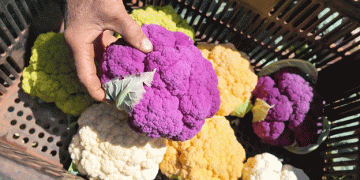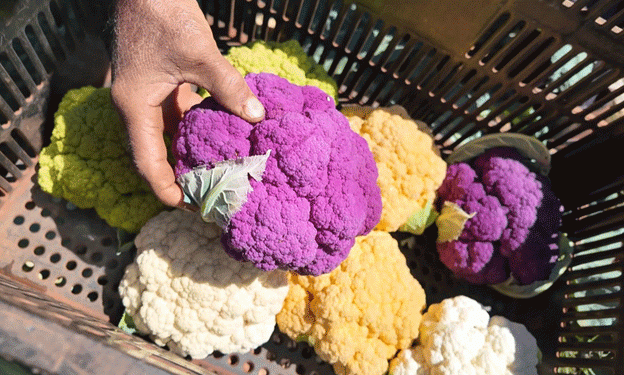In a groundbreaking move for Brazilian agriculture, a producer from Barrinha, São Paulo, has successfully grown all four known cauliflower varieties—white, purple, orange, and green. While traditional white cauliflower is a staple in Brazilian kitchens, these vibrant colors have captured attention, previously seen only in regions like Asia, Australia, and North America.
According to the farmer, this year marked the first time he was able to harvest all four colors together, a feat that required careful planning and timing. “We have a window of just two and a half months to cultivate in our region. Each variety has a different growing period—the white cauliflower has its own cycle, while the purple is the latest to mature. We have to synchronize the planting to harvest them all at the same time,” he explained.
The production takes place during the cooler months of the year, as Brazil’s tropical climate limits the growth window for cauliflower. Beyond the visual appeal of the colors, each variety of cauliflower offers unique nutritional benefits.
Each Color, a Different Nutrient Profile
Though still a rarity in Brazil, colored cauliflower varieties pack a powerful nutritional punch. All varieties are rich in fiber, folic acid, vitamin C, and essential minerals like magnesium and potassium. However, each color brings its own specialized nutrients to the table.
“The purple cauliflower is rich in anthocyanins, the antioxidant compound that gives it its reddish-purple hue,” explains the farmer, referencing its health benefits, including anti-inflammatory properties. The orange variety, on the other hand, is loaded with beta-carotene, a precursor to vitamin A, similar to what is found in carrots and pumpkins. Meanwhile, the lime-green cauliflower is high in folic acid and vitamin C, making it a powerhouse for immune support.
Interestingly, the green variety is believed to be a natural cross between broccoli and cauliflower, its color resulting from the high chlorophyll content. The purple and orange types, however, are the products of natural genetic mutations. “Breeders have been working on crossing and improving these varieties for years to create the vibrant hybrids we see today,” the producer explains. “The taste is quite similar to the white cauliflower, though the purple has a slightly stronger flavor.”
Innovative Marketing and Sales Strategy
The decision to grow colored cauliflower wasn’t just about the novelty—it was a strategic move to boost sales and diversify the farm’s offerings during the colder months. “During this time of year, leafy vegetable sales tend to drop, so we decided to broaden our product range. We enjoy working with unique crops, so we thought, why not grow these colorful cauliflowers?” says the farmer.
Initially, the brightly colored cauliflower surprised customers, many of whom thought the purple variety was artificially dyed. However, as word spread and curiosity grew, the market gradually embraced the vibrant vegetable. “People are intrigued, and they love using the colored cauliflower in salads because it looks so beautiful. Even kids, who can be picky about vegetables, are more likely to try it because of the striking colors.”
The producer’s investment in colorful cauliflower not only satisfies aesthetic and culinary demands but also taps into a growing trend of healthy eating. The bright colors make the vegetables more attractive, especially to health-conscious consumers seeking nutrient-dense options.
The introduction of colorful cauliflower to Brazil’s agricultural landscape is a testament to innovation in farming. By synchronizing cultivation cycles and offering unique, nutrient-packed varieties, the producer has found a way to stand out in a competitive market. As Brazilian consumers become more health-conscious and open to diverse vegetable options, these vibrant cauliflower varieties are poised to become a regular feature in kitchens across the country.
































